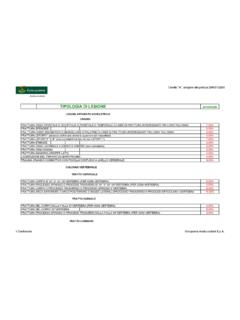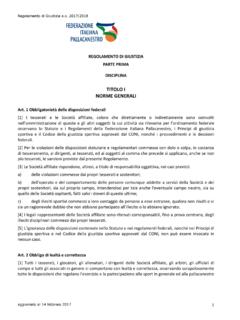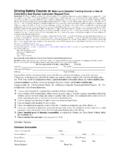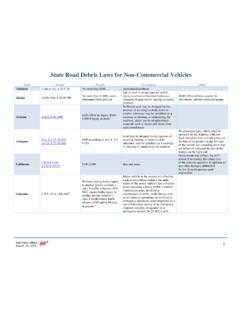Transcription of THE DRIBBLE, DRIVE, MOTION OFFENSE - official site
1 By Vance WalbergVance Walberg is the assistant basketball coach of the University of Massachusetts, and the creator of dribble , drive , MOTION OFFENSE , a great and unique attack that has been adopted by many teams in the United States. He was formerly the head coach at Clovis West High School (Fresno, Califor-nia) for 17 years. As head coach at Fresno State City College, his team won the 2005 California State Community College title. From 2006 to 2008, he was head coach at Pepperdine University. A PREMISENo matter what you like to call it, the "At-tack-Attack-Skip-Attack-Attack" (AASAA) or the " dribble drive MOTION " (DDM) OFFENSE has skyrocketed to the top of the basketball world since its creation in 1997.
2 Just ask the NCAA finalist Memphis Tigers or the World Champions Boston Celtics, who have incor-porated parts of the OFFENSE . The OFFENSE of-fers very few ball screens, along with very little play calling. There is nothing like this offensive set in the basketball world. The of-fense certainly seems a little radical, since it goes against what has been thought to be the right way to run an OFFENSE . Instead, this OFFENSE leads to plenty of dunks, lay-ups, three-point shots, and just trying to flat out beat your man off the dribble . Players love to run the OFFENSE , coaches love to teach it, fans love to watch it, and every basketball fan should enjoy this breath of fresh air in the game of THIS OFFENSE GOT ITS STARTHow did this OFFENSE get its start?
3 That ques-tion can be traced back to 1997 when I was a high school coach at Clovis West High School in Fresno, California. There, I had a problem on my hands that all coaches would love to have. I had two explosive point guards in Chris Hernandez and Tyrone Jack-son, two players, who could get to the rim anytime they wanted. The problem was that with traditional offenses, there was too much congestion in the paint and it made it difficult for them to get to the rim. Like all major breakthroughs, I had to think outside the box and come up with something that really went against the grain.
4 Spacing would be the secret to solving this problem, and the first step was moving the post man to the weak side block. With the post man on the opposite side of the lane, it really gave Chris and Tyrone the chance to blow by their defenders and get to the rim without having to deal with sagging defenders. Next step, if either of the guards were picked up by the post defender, he would throw a sim-ple pass to the post man for an easy lay-up. If one of the guards did not have the lay-up and the post man was not open, he would kick the pass out to a teammate for the three-point shot.
5 If the player didn t have this shot, he would attack again, never giv-ing the defense a chance to rest. AASAA is not a fancy name, but it flat out describes the OFFENSE best. WE LIKE 3-POINTERS, BUT WE LOVE LAY-UPS This slogan is attached to every high school or college team that I have coached. For me, a perfect shot chart would have every single shot taken from right around the rim or a three-point shot (see the shot chart). Mid-range shots and long two s have no place in this OFFENSE . The goal for any team that runs the OFFENSE should be to spread the defense out and relentlessly attack the gaps.
6 This is not a gimmick OFFENSE , but one that has been thought through to give your team the best advantage possible, especial-ly mathematically. Imagine you are coach-ing with 7 seconds left, you have the ball, and you are down one point. What would you tell your team? Most coaches would say get to the basket and try to draw a foul or make something happen. Well, this of-fense takes that same strategy for the full 32 minutes in high school and the full 40 min-utes in college. POINT PER POSSESSION CHARTTo fully comprehend this OFFENSE , you need to understand what Points per Possession (PPP) mean.
7 PPP means how many points you score on each possession that you have during the game. A possession is once you have the ball and either score or lose it to the other team. Good teams will score at a clip of PPP. Now, to understand this, we actually break down what your team shoots " dribble , drive , MOTION " OFFENSE page 20 | 35 2008 | Fiba Assist Magazine COACHES - each shot. Most people would say that the inside shot (lay-ups, offensive put backs, steals for lay-ups, drives) would be the best. Most teams shoot approximately 60% from this area so that would put you at a PPP for lay-ups (60% x 2 points = ).
8 Next, the three-point shot could be a high one if you can hit 40% of your three-point as this would put you at PPP (40% x 3 points = ). Realistically, most teams are around 35%, so this means that the three pointer is now worth (35% x 3 points = ). Any-thing above 1 is good and the three-point shot falls into that range. The best shot though is the free-throw. Teams usually shoot 70% from there and that would put you at PPP (70% x 2 FT s = ). Think about it: the two highest PPP are the free-throw and the inside shot. These go hand in hand. To get to the free-throw line you have to attack the rim, so doesn t it make sense to come up with an OFFENSE that gives your players the best chance to succeed in this area?
9 A very interesting side note is that Coach John Calipari from Memphis charted for two consecutive years (205-2007) what his team shot from mid range (13 to 19 feet) and it was 28%. This would put mid-range shots at a .56 PPP. Most teams usually shoot 35% from this area and that still only gives you a PPP. The only worse PPP would be the turnover, which is obviously 0 PPP (diagr. 1).THE GAPS CHARTThe goal for any team that runs this OFFENSE should be to spread the defense out and Assist Magazine | 35 2008 | Page 21 lentlessly attack the gaps. I will now explain the difference between single, double, and triple gaps and, obviously, the bigger the gap, the easier it is to succeed.
10 (diagr. 2, 3, 4, and 5). To make this as easy as possible, the adjustment was made to have four pe-rimeter players and one interior player al-ways on the weak side block. Another difference for me is the way I number my players. My 1 is the traditional point guard and my 5 is another penetrating guard (hopefully, taller). The 1 and 5 are penetra-tors first, outside shooters second. These two are the bookends of the OFFENSE . They are constantly attacking the rim. I originally had the big player take it out, but when teams would double the point and the ball went back to the big, it slowed down the of-fense way too much.
















